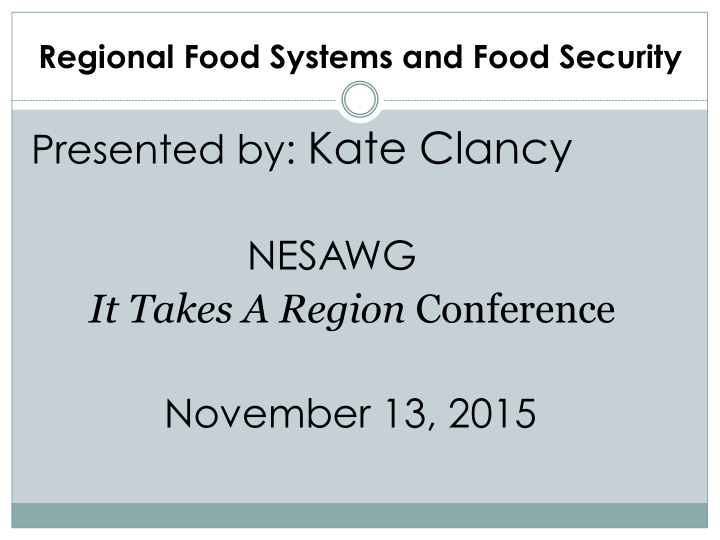



Regional Food Systems and Food Security Presented by: Kate Clancy NESAWG It Takes A Region Conference November 13, 2015
Two Major Components 1. Food security of a nation or region of the country producing enough food to feed itself in the event of crop failure or import shortfalls (FAO 1981), measured by food self-sufficiency ratio. 2. Food security of a community: “a condition in which all community residents obtain a safe, culturally acceptable, nutritionally adequate diet through a sustainable food system that maximizes community self-reliance and social justice.” (Hamm & Bellows, 2003)
Why Approach Through Both Lenses? The primary outcome of every generic food system is food security (Ericksen 2007). Low-income populations don’t exist in a vacuum. Need to address significant differences while moving to more inclusive picture.
Analyzing Food Security in Context of Drivers and Feedbacks GEC Drivers Environmental Changes in: Feedbacks • Land cover and soils Food System Activities • Atmospheric composition (water quality, Producing • Climate variability and means Processing and packaging greenhouse • Water availability and quality gases) Distributing and retailing • Nutrient availability and cycling Consuming • Biodiversity Natural Drivers • Sea currents and salinity (volcanoes, • Sea level solar cycles) ↑ Food System Outcomes Drivers ’ Contributing to Food Security, Interactions Environmental Security, and Other Socioeconomic Drivers Societal Interests: Changes in: • Food utilization • Demographics • Food availability Socioeconomic • Economics • Social welfare Feedbacks • Socio-political context • Food access (livelihoods, • Cultural context • Environmental capital social • Science and technology cohesion) Source: Ericksen, P. GECAFS. 2009.
What is Food Justice? From B. Gottlieb & A. Joshi – Food Justice Ensuring that the benefits and risks of where, what, and how food is grown and produced, transported and distributed, and accessed and eaten are shared fairly. By elaborating what food justice means and how it is realized in various settings, we hope to identify a language and a set of meanings, told through stories as well as analysis, that illuminate how food injustices are experienced and how they can be challenged and overcome.
Why Engage Food Security at the Regional Level? 1. “It is at the regional level that many earth system changes are significant – altering flows of water, trade, disease, and human migration.” (Ericksen 2007) 2. Regional is an “appropriate scale for addressing rural development, urban regeneration, agricultural food strategies, and producer and consumer reconnection.” (Kneafsey 2010)
Assumptions about a Regional Approach Offers a more ecological focus on population density, environmental conditions, and marketing infrastructure. Provides clearer conceptualization than local or global for a system that describes the complex plans, processes, and relationships of present-day food systems (Donald 2010). The concept of region is different according to context. Regions evolve. Some concepts apply to localization.
Tufts Sustainable Diets Working Group Funding in 2012 from Tufts Collaborates Intent to produce comprehensive set of sustainable dietary guidelines Decided we needed a framework to sort out multiple issues
Tufts Sustainable Diets Working Group (cont.) Over a year of discussions on many topics ¡ What is the scope? ¡ Need for systems approach ¡ What constitutes guidance? ¡ What are potential audiences for guidance? ¡ Who are potential developers of guidance? ¡ Balance of simplicity and complexity
Guidance content development Principles/values Vision (e.g. underlying purpose of SDG) Evidence base for specific guidance items Prioritizing across contradictory factors
Guidance framework components User audiences Outcomes/applications Intermediaries and partners Capacity assessment
Scoping paper for Global Alliance for Future of Food Review of global FBDG and sustainable diet guidance Challenges to develop SDG multi-disciplinary and systems-based; more data needed; scale is critical; are multiple influences on consumers and supply chains; politics Recommendations to funders
Recommend
More recommend